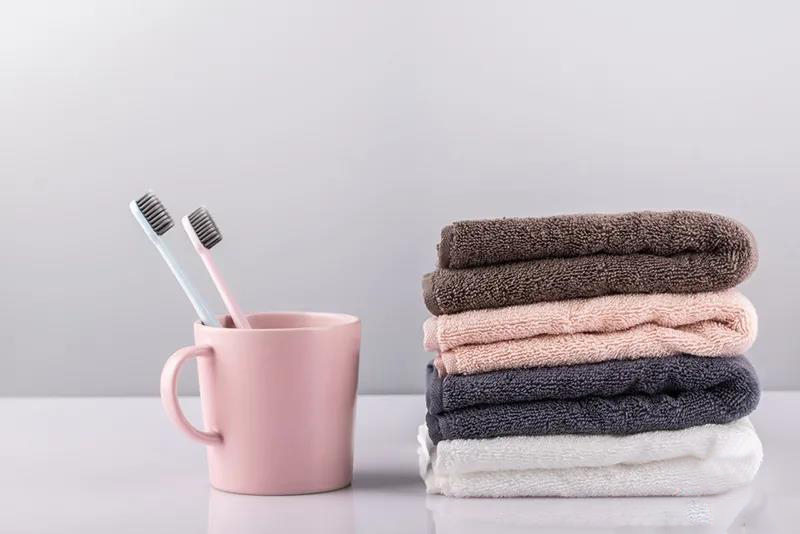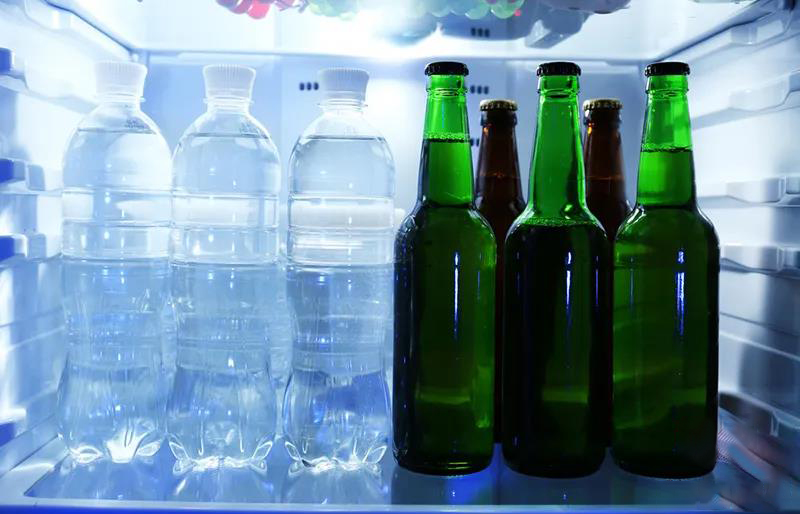
Concentrated nitric acid should be stored in a brown bottle and protected from light, because concentrated nitric acid is easy to decompose when exposed to light
Is it because you are afraid of decomposing beer in green bottles? But why is baijiu packed in transparent bottles again?
Q1: Why do towels become harder and harder as they become thinner and thinner?
After a period of use, the originally fluffy towel will become hard and rough. This phenomenon is caused by many factors.

Some tap water contains high levels of soluble calcium and magnesium compounds. Although it will not directly affect our health, it will bring trouble to towels. The calcium and magnesium ions in the water can interact with the fatty acid sodium in the soap to form water-insoluble calcium and magnesium fatty acid salts that adhere to the towel, causing the towel to become harder and harder.
In addition, the natural air-drying method will also affect the hardness of the towel. Microscopically, cotton towels are composed of cotton single fibers. Due to the surface tension of water, there is capillary action between the fibers.
Therefore, during the drying process, the distance between the fibers will decrease as the moisture decreases. The research team simulated the process of drying towels under natural conditions and found that about 8% of the water remained in the area shown in the figure above in the form of bound water. The cotton single fiber cross-linked structure formed in this way changes the hardness of the towel.
And experiments show that after heating to remove the bound water in the dried towel, the towel is soft and fluffy in touch and vision.
Q2: Why is the beer bottle color greenish brown, while the white wine bottle is transparent?
In fact, it’s because the beer in green bottles is traditional.
Beer in glass bottles only appeared in the 19th century. In the beginning, the glass manufacturing process was not very exquisite, and the ferrous ions in the raw materials were difficult to remove, and the glass bottles were naturally green. Later, the craftsmanship went up to remove these impurities, but the cost also went up. More importantly, people found that green bottles can delay beer’s taste, so it has become a tradition to use green bottles for beer. People specialize in the production of green bottles added with coloring agents such as ferrous oxide and chromium oxide.

In the 1930s, it was discovered that brown bottled beer did not change its taste even after being left for a long time. This is because brown bottles can avoid the effects of light.
Under light conditions, the bitter component of hops oxalin will help synthesize riboflavin, and at the same time, the iso-alpha acid in beer will react with riboflavin to decompose into a compound, which has a “fresh fragrance” similar to the fart of a weasel “Taste”, so the use of brown bottles that can absorb most of the light became the trend at that time. Unfortunately, brown bottles were in short supply during World War II, and green bottles regained part of their lost ground. In the future, with the development and popularization of sealing technology and refrigerators, brown bottles no longer have such a big advantage in preserving beer, and most wineries will reuse green bottles.
As for white wine, due to the different ingredients, white wine has no special requirements for storage (except for long-term storage and other appreciation). In addition, bottled white wine appears late and the process is mature, so I don’t care about the color of the bottle, but transparent. The bottle can highlight the clarity of the liquor. Of course, the use of ceramic bottles by some manufacturers is purely characteristic of manufacturers.
One final reminder: drink healthy, don’t be greedy. (Drink without driving, driving without drinking)
Q3: How is static electricity generated in winter, and how can it be eliminated or reduced?
It is said that winter is easy to “crack”, this is mainly because of “water shortage”. Since the skin exposed to the air can slowly transfer electrons when it comes in contact with water vapor (different from fast-moving electrons, which do not cause contact inductance), it is possible to offset the transfer when the human body rubs against other objects. In this way, the number of times of generating static electricity is naturally less.
In winter, the air is relatively dry, and there is no sufficient amount of water vapor to help offset it, and it is easier to generate static electricity. Another point is that if the clothes on the body are made of chemical fiber fabrics, they can easily transfer away the electrons in the human body after rubbing with the human body, and the electrons are firmly “locked” in the clothes, which makes the human body exposed to static electricity for a long time. State”, which frequently generates static electricity (it makes matters worse=_=).

Although static electricity does not cause fatal harm to the human body, it is really uncomfortable to be electrically charged again and again. What are the good prevention strategies?
Obviously, we can increase the humidity of the skin surface, applying moisturizer is a good way.
It is also excellent to avoid chemical fibers when dressing and choose cotton clothing (cotton is more hydrophilic and can transfer electrons by absorbing moisture). If you want to achieve 100% elimination, there is also a way: hold a wooden product, and let the wooden product contact an object prone to static electricity (such as metal) for a few seconds. This can also cause the electrons to slowly transfer. After the charge level is balanced, the static electricity is naturally eliminated.
Q4: Why is the rhythm of moving and playing so exciting?
When listening to songs, people often spontaneously “move once and hit once” as shown in the picture below, and then the atmosphere of the music will be inspired, and they will be happy like a child when they listen to the song. So why does the so-called “moving times hitting times” have this effect.
First of all, “Dong times hit times” corresponds to the 4/4 time in music theory, that is, a quarter note is a beat, and there are four beats in each bar. These four beats correspond to the move, time, beat, and time, respectively. Strong, weak, second strong and underbeat. The reason why “playing times and times” is so common is that most of the music encountered in daily life is in 4/4 beats. In 4/4 beats music, the alternation of strength and weakness is more frequent, which can particularly drive emotions and is popular, it’s the most common rhythm pattern in music.

Psychology researchers have explored the effects of several typical rhythmic music on individual subjective music emotions and changes in individual brain neuroimaging activities. The experimental results show that different rhythmic patterns activate and inhibit different areas of the brain, only 4/4 Beat rhythmic music activates bilateral auxiliary motor areas and bilateral superior temporal gyrus, and 4/4 beat rhythmic music induces the highest arousal and highest pleasure.

Psychology researchers also consider that individuals are more familiar with 4/4 beats, so this sense of pleasure and arousal may be caused by familiar rhythm patterns. This explains why “Dong times hit times” is more “sense” than other rhythm types.
Comments